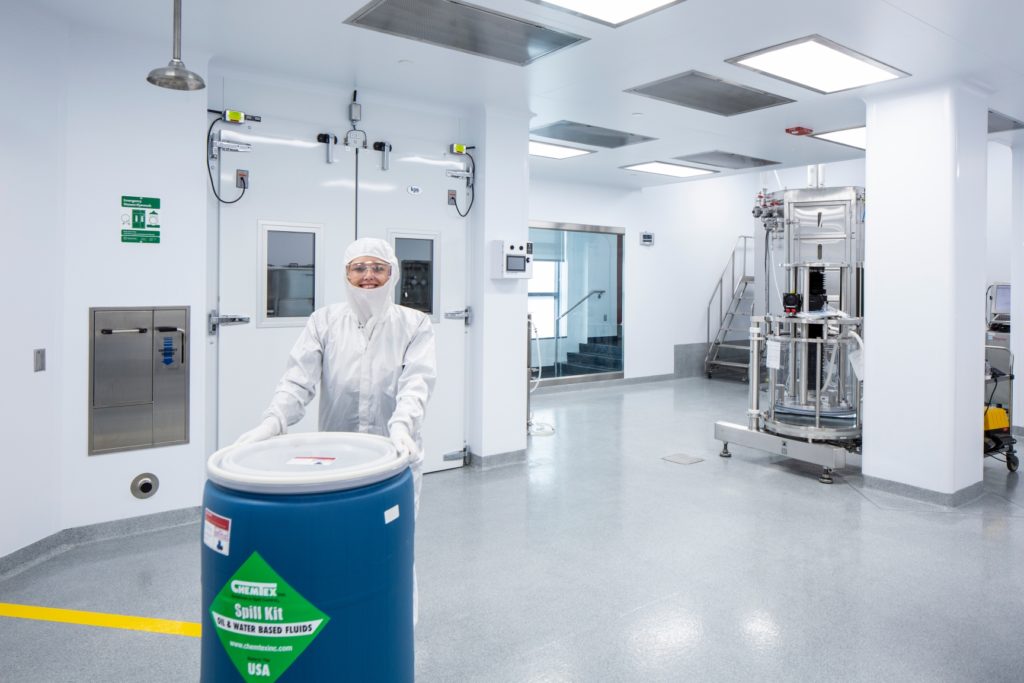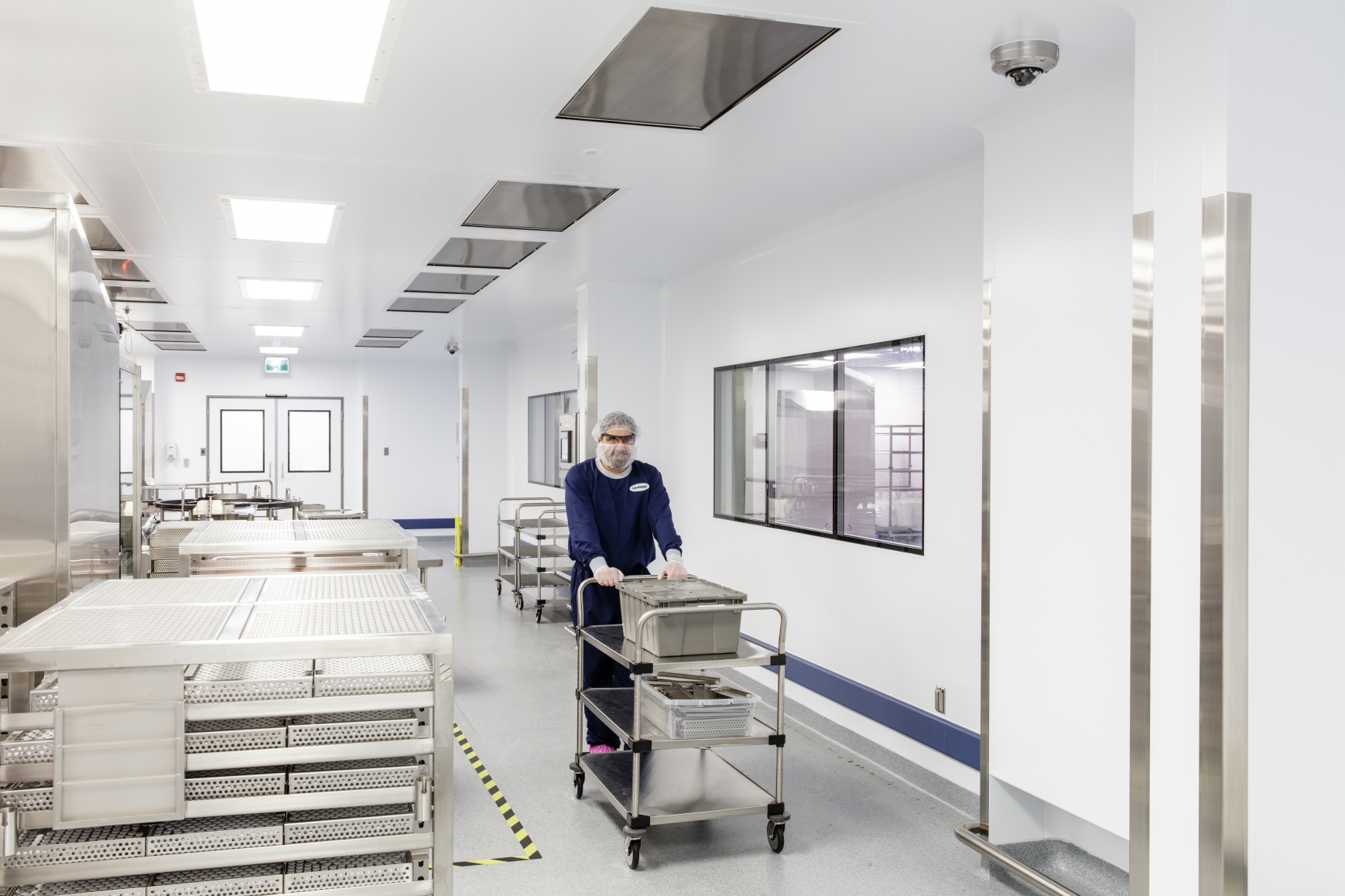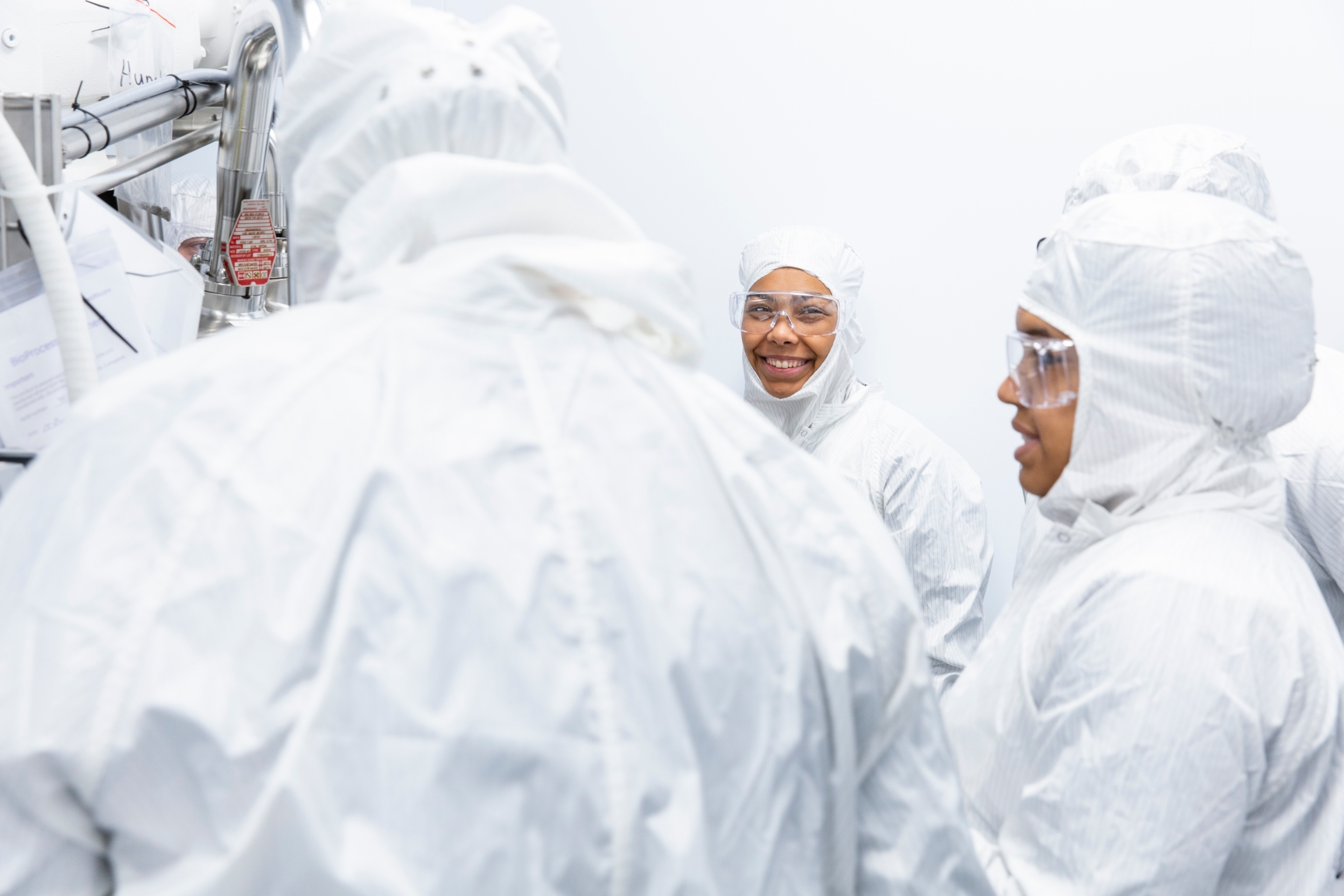Superior Biopharmaceutical Manufacturing Facilities Prioritize Cleaning & Disinfection During Cleanroom Design
By Mitch Gonzales, AES Clean Technology, and Brian Weed, Controlled Contamination Services 
Overlooking a cleaning and disinfection scheme as part of a biopharmaceutical manufacturing facility’s cleanroom design and construction is an all-too-common misstep in effective cleanroom design and operation.
Between 2015 and 2019, FDA industry compliance requirements for cleaning, sanitization, and maintenance under section 21 CFR 211.671 yielded a total of 381 FDA citations (i.e., Form 483 Inspectional Observations). In 2019 alone, 99 observations were issued, elevating “equipment cleaning and maintenance” to the fifth-most prevalent type of citation issued by FDA that year.
Contamination control (21CFR 606.145.a)2 also represents a high-incidence FDA observation category. The FDA provides specific guidance3 for cross-contamination control in product license applications, requesting a narrative description of the procedures and/or facility design features for cross-contamination control and containment.
Still, biopharmaceutical firms contracting out cleanroom design and cleanroom construction services often focus only on core, process-specific facility attributes, underestimating the importance of an integrated cleaning and disinfection strategy. Or those firms consider cleaning and disinfection strategy the realm of whomever is contracted to handle such maintenance later.
While this dynamic frequently is true, decisions made during modular cleanroom design — based on considerations of multiproduct use, processing steps, operational flows, and the challenge of cleaning particular structures or surfaces — greatly impact a facility’s start-up and long-term operational cost. These decisions also can shape the ease of facility expansion while minimizing the risk of construction contamination due to ongoing GMP production operations.
In this article, we examine how cleanroom design and construction techniques, as well as construction materials, impact the cleaning and disinfection of classified areas. Also discussed are critical factors influencing the schedule, quality, and lifecycle cost of a newly constructed biomanufacturing facility.
Cross-functional Input is Key to Success
Contamination control should be viewed as an interrelated science between people, product, process, air, and surfaces. However, executive stakeholders focused on strategic aspects of the project, versus a facility’s operational implications, often minimize the importance of operational factors.

A failure to plan ahead, leveraging diverse internal and/or third-party expertise, regularly leads to qualification or production delays and, in worst-case scenarios, has led to post-construction modification or redesign and construction of cleanroom areas once issues have been identified by functional plant staff who oversee the daily production operations.
Start with a Clean Slate
Designing and building a cleanroom facility with cleaning efficacy as a key outcome requires understanding three elements: 1) traditional cleaning methodologies, 2) room design, and 3) materials of construction.
Traditional cleaning methodologies still reign — The three-bucket system (cleaning solution bucket, waste bucket, and rinse bucket) traditionally has been applied to cleanrooms, from cleanroom floors and cleanroom walls to other contact surfaces. In support of this proven methodology, The Institute of Environmental Sciences and Technology (IEST) has established recommended practices4 to help cleanroom operators set standard operating practices (SOPs) for cleaning and sanitization.

The industry also has explored cleaning methodologies using vaporized hydrogen peroxide (VHP) and chlorine dioxide (CD), though VHP has enjoyed more success. VHP’s principal use has been in isolator environments — small, tightly controlled spaces — though its use is increasingly accepted within entire cleanrooms. This is because VHP can sterilize a room in a matter of hours (e.g., overnight) and is not as labor intensive as other cleaning techniques.
However, VHP use presents numerous challenges: the room must be sealed off, air circulation must be precise, VHP’s “kill count” is not as high as chemical contact, and VHP does not remove physical particles whose surface area can attract contaminants.
UV light, too, has been considered for cleanroom cleaning and sterilization but, like VHP, its drawbacks consistently outweigh the benefits of its use. Most notably, the lamps (particularly purchased at scale) can be prohibitively expensive, and their kill count is limited by line of sight. Further, the lamps’ effectiveness diminishes over time, and the UV wavelengths required to kill microorganisms are not safe for (human) individuals.
Room design is better served in modular cleanroom builds — The cornering on modular cleanroom builds is more conducive to a sterile environment, in that difficult-to-clean 90-degree corners, either on coping or in wall corners, are eliminated. Modular cleanrooms’ PVC radius corners leave no hazardous edges that could cut cleaning crew and the flush edges extend the life of cleaning equipment/supplies. PVC radius corners also promote superior air flow throughout the room, moving air in a more controlled pattern that optimizes air and particle movement to promote cleanliness.
These elements are blended with HVAC systems in the ceiling and an epoxy resin floor to create an environment conducive to cleaning efficacy. Simply put, a cleanroom facility that is smooth, continuous, and crevice-free promotes a cleaner environment and helps ensure cleanroom technology best practices.
Also, regardless of the cleaning methodology selected, cleanroom designers must ensure traffic patterns (i.e., the flow of materials, personnel, and waste) are not prohibitive to the cleaning methodology. For most cleanrooms, traditional “bucket system” cleaning methods will be used and — in addition to HVAC placement — the principal considerations are access to a water source and waste disposal.
In a modular cleanroom build, minimalist janitorial closets (e.g., a floor sink, some mop storage, and individual reverse osmosis [RO] or deionized [DI] purified water processing units, per the customer’s request) are implemented where they’ll be both unobtrusive to cleanroom staff and conveniently accessed by cleaning personnel. Cleaning is optimized to occur at times and on paths that will not compromise cross-contamination control.
Construction materials make all the difference — Cleanrooms can be constructed using two methodologies: 1) traditional “stick build” construction, where all materials are stored and adapted to fit the intended use while on the project site, or 2) modular cleanroom construction, where panels are prefabricated at their site of manufacture, formed with materials specifically designed for cleanroom environments, and sequentially delivered to the project site as needed, requiring minimal staging and storage.
In traditional construction, materials are not delivered in a condition intended for cleanroom applications: large quantities of drywall, paint, glue, PVC, and metals all require considerable cutting and finishing labor manipulation to achieve fit for purpose. Further, PVC materials applied over stick builds use heat-welded PVC at the seams. This seal has plasticizers to make it flexible, but is susceptible to absorbing DECON materials, causing quick discoloration or moisture penetration into the wall backing, introducing a source of microbial contamination to the facility.
Moreover, these porous materials require periodic refurbishing (or refinishing) year-over-year, be it repainting or replacing cover panels, and room alterations comprise a major undertaking impeding existing supply operations. Additionally, damage to stick builds during regular facility operation can create contamination that risks batch quality, with significant cost and schedule (i.e., room downtime) implications.
In modular cleanroom construction, a system of panels is prefabricated with contiguous materials, such as metal and high-grade unplasticized PVC (uPVC). Coated uPVC modular panels contain no plasticizers and utilize a PVC cold weld for seams. These materials of construction are proven to withstand daily contact with common detergents, phenolics, quaternaries, and sporicides. They also offer known efficacy during cycling studies. Further, modular builds integrate flush windows and doors with DECON-compatible frames, which minimize or eliminate crevices and snag areas inimical to common cleaning pads.
Modular cleanroom panels’ assembly and finishing are certified to match specification and each panel is individually wrapped prior to shipment from the manufacturer’s plant, resulting minimal particle exposure. Upon just-in-time modular delivery to the project site, an estimated 95 percent of modular cleanroom system components are ready for install without further cutting, dramatically reducing particle generation and accelerating cleanroom startup qualification activities.
Consider the pace at which cell & gene therapies must move through their development and commercialization lifecycles. A modular cleanroom facility designed, constructed, and validated through pre-license / pre-approval inspections (PLI and PAI, respectively) several weeks or months ahead of what is possible with a traditional cleanroom build — in addition to its operational efficiency benefits — enables production (and profitability) to begin sooner.
Conclusions
Modular cleanroom design/builds, due to their fit, form, and function, are proven to improve both cleaning efficacy and cleaning efficiency — in addition to their benefits to aggressive design-and-build schedules, facility longevity, and room flexibility throughout the facility’s lifecycle.
Modular builds represent both the present and the future of sterile facility design. Their numerous advantages render stick builds (and their significant risk of material failure) obsolete.
About The Authors
Mitchell Gonzales is VP of Process Technology at AES Clean Technology. Mitch is a leader with 25+ years of progressive experience in the biotechnology, biosimilar, gene therapy, and pharmaceutical industries. His experience centers on aseptic biopharmaceutical operations (e.g., engineering, manufacturing, clinical development, supply chain, technical transfer), working for large and start-up companies. Mitch holds PMP and Six Sigma Green Belt certifications and has extensive global experience that includes two decades in the CMO/CDMO outsourcing industry. His achievements include multiple biopharmaceutical commercial launches for new and extension products.
Brian Weed is VP of Sales for Controlled Contamination Services (CCS), where he directs all U.S. sales managers and marketing activities. Brian has more than 14 years of experience in the life sciences sector, GMP environments, bio-containment facilities, and bio-decontamination, both in business development and managing operating teams servicing highly regulated, controlled environments. Brian also has served as CCS’ Director of Business Development for the East Region. Prior to CCS, Brian held positions including regional sales manager and director of a division for an international provider of bio-decontamination services to the life sciences industry, where he was responsible for service delivery in the U.S., in addition to completing projects in Brazil, Panama, and Canada. Brian holds a BS in Mechanical Engineering from Villanova University.
About AES Clean Technology
AES Clean Technology is an industry leader dedicated to modular cleanroom systems and their innovation having 35 years of expertise in the design, fabrication, and installation of cGMP manufacturing facilities. For more information about our innovative modular cleanroom construction and cleanroom technologies, contact us here.
Resources
- 1. “CFR – Code of Federal Regulations Title 21.” Accessdata.fda.gov, U.S. Food & Drug Administration, Revised 1 Apr. 2019,
www.accessdata.fda.gov/scripts/cdrh/cfdocs/cfcfr/CFRSearch.cfm?fr=211.67
- 2. “CFR – Code of Federal Regulations Title 21.” Accessdata.fda.gov, U.S. Food & Drug Administration, Revised 1 Apr. 2019,
https://www.accessdata.fda.gov/scripts/cdrh/cfdocs/cfcfr/CFRSearch.cfm?fr=606.145
- 3. FDA CMC Guidance for Industry for the Submission of Chemistry, Manufacturing, and Controls Information for a Therapeutic Recombinant DNA-Derived Product or a Monoclonal Antibody Product for In Vivo Use
- 4. IEST-RP-CC018: Cleanroom Cleaning and Sanitization: Operating and Monitoring Procedures. Working Group 018. IEST Contamination Control Division (WG-CC018). May 2020.
https://www.iest.org/Standards-RPs/Recommended-Practices/IEST-RP-CC018
- 5. ISO 14644 Standards, Cleanroom Standards
- 6. ISO 14698 Standards, International Standards on biocontamination control for cleanrooms
- 7. IEST-RP-CC0012, Clean Build (construction contamination control)

